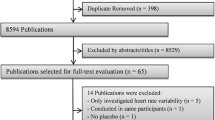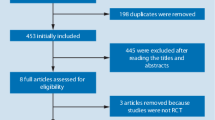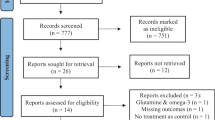Abstract
Objective
To determine the effects of n3-PUFA supplementation, in the dose used in the GISSI-Prevenzione study, on indices of heart rate variability (HRV) in patients following myocardial infarction (AMI).
Materials and methods
Open label randomised single blind controlled trial. Thirty eight patients post AMI, stable on standard secondary prevention drug therapy were single blind randomised to receive either Omacor 1 g/day (n = 21) or usual care (n = 17). HRV indices (time and frequency-domain) were measured at baseline and following 3 months of treatment.
Results
At baseline there were no significant differences in clinical, biochemical or HRV indices between patient groups. After 3 months therapy there were no observed changes in measured HRV indices in either the Omacor supplemented or ‘usual care’ groups.
Conclusions
Three month supplementation of omega 3 PUFA (Omacor) 1 g/day has no effect on HRV is patients post AMI.
Similar content being viewed by others
References
Burr ML, Fehily AM, Gilbert JF, Rogers S, Holliday RM, Sweetnam PM, et al. Effects of changes in fat, fish and fibre intakes on death and myocardial infarction: diet and reinfarction trial (DART). Lancet 1989;ii:757–61.
Simopoulos AP. Omega-3 fatty acids in the prevention-management of cardiovascular disease. Can J Physiol Pharm 1997;75:234–9.
GISSI-Prevenzione Investigators. Dietary supplementation with n-3 polyunsaturated fatty acids and vitamin E after myocardial infarction: results of the GISSI-Prevenzione trial. Lancet 1999;354:447–55.
Thies F, Garry JM, Yaqoob P, Rerkasem K, Williams J, Shearman CP, et al. Association of n-3 polyunsaturated fatty acids with stability of atherosclerotic plaques: a randomised controlled trial. Lancet 2003;361:477–85.
Brown AA, Hu FB. Dietary modulation of endothelial function: implications for cardiovascular disease. Am J Clin Nutr 2001;73:673–86.
Lee KW, Blann AD, Lip GY. Effects of omega-3 polyunsaturated fatty acids on plasma indices of thrombogenesis and inflammation in patients post myocardial infarction. Thromb Res 2006;118(3):305–12.
Patel JV, Lee KW, Tomson J, Dubb K, Hughes EA, Lip GY. Effects of omega-3 polyunsaturated fatty acids on metabolically active hormones in patients post myocardial infarction. Int J Cardiol 2006 (June 14). http://dx.doi.org./10.1016/j.ijcard.2006.04.004.
Christensen JH, Gustenhoff P, Korup E, Aaroe J, Toft E, Moller J, et al. Effect of fish oil on heart rate variability in survivors of myocardial infarction: a double blind randomised controlled trial. BMJ 1996;312:677–8.
Christensen JH, Korup E, Aaroe J, Toft E, Moller J, Rasmussen K, et al. Fish consumption, n-3 fatty acids in cell membranes, and heart rate variability in survivors of myocardial infarction with left ventricular dysfunction. Am J Cardiol 1997;79:1670–3.
Christensen JH, Dyerberg J, Schmidt EB. N-3 fatty acids and the risk of sudden cardiac death assessed by 24-hour heart rate variability (abstract). Lipids. 1999;34 Suppl S197.
Christensen JH, Skou HA, Fog L, Hansen VE, Vesterlund T, Dyerberg J, et al. Marine n-3 fatty acids, wine intake and heart rate variability in patients referred for coronary angiography. Circulation 2001;103:651–7.
Hamaad A, Lip GY, MacFadyen RJ. Unheralded sudden cardiac death: do autonomic tone and thrombosis interact as key factors in aetiology? Ann Med 2003;35:592–04.
Hull SS Jr, Evans AR, Vanoli E, Adamson PB, Stramba-Badiale M, Albert DE, et al. Heart rate variability before and after myocardial infarction in conscious dogs at high and low risk of sudden death. J Am Coll Cardiol 1990;66:978–85.
Molgaard H, Sorensen KE, Bjerregaard P. Attentuated 24-h heart rate variability in apparently healthy subjects, subsequently suffering sudden cardiac death. Clin Auton Res 1991;1:233–7.
Scwartz PJ, La Rovere MT, Vanoli E. Autonomic nervous system and sudden cardiac death. Experimental basis and clinical observations for post-myocardial infarction risk stratification. Circulation. 1992;85:I77–91.
Kleiger RE, Miller JP, Bigger JT, Moss AJ. Decreased heart rate variability and it’s association with increased mortality after acute myocardial infarction. Am J Cardiol 1987;59:256–62.
Billman GE, Kang JX, Leaf A. Prevention of sudden death by dietary pure omega-3 polyunsaturated fatty acids in dogs. Circulation 1999;99:2452–7.
Xiao YF, Kang JX, Morgan JP, Leaf A. Blocking effects of polyunsaturated fatty acids on Na+ channels of neonatal rat ventricular myocytes. Proc Natl Acad Sci USA 1995;92:11000–4.
Xiao YF, Gomez AM, Morgan JP, Lederer WJ, Leaf A. Suppression of voltage-gated L-type Ca2+ currents by polyunsaturated fatty acids in adult and neonatal rat cardiac myocytes. Proc Natl Acad Sci U S A 1997;94:4182–7.
Xiao Y-F, Wright SN, Wang GK, Morgan JP, Leaf A. Fatty acids suppress voltage-gated Na+ currents in HEK293t cells transfected with the α-subunit of the human cardiac Na+ channel. Proc Natl Acad Sci U S A 1998;95:2680–5.
Leaf A, Kang JX, Xiao Y-F, Billman GE. Dietary ω-3 fatty acids in the prevention of cardiac arrhythmias. Curr Opin Clin Nutr 1998;1:225–8.
Christensen JH, Aaroe J, Knudsen N, Dideriksen K, Kornerup HJ, Dyerberg J, et al. Heart rate variability and n-3 fatty acids in patients with chronic renal failure—a pilot study. Clin Nephrol 1998;49:102–6.
Christensen JH, Christensen MS, Dyerberg J, Scmidt EB. Heart rate variability and fatty acid content of blood cell membranes: a dose response study with n-3 fatty acids. Am J Clin Nutr 1999;70:331–7.
Villa B, Calabresi L, Chiesa G, Rise P, Galli C, Sirtori CR. Omega-3 fatty acid ethyl esters increase heart rate variability in patients with coronary disease. Pharmacol Res 2002;45:475.
Geelan A, Zock PL, Swenne CA, Brouwer IA, Schouten EG, Katan MB. Effect of n-3 fatty acids on heart rate variability and baroreflex sensitivity in middle age subjects. Am Heart J 2003;146:E4.
Marchioli R, Barzi F, Bomba E, Chieffo C, Di Gregorio D, Di Mascio R, et al. Early protection against sudden death by n-3 polyunsaturated fatty acids after myocardial infarction: time-course analysis of the results of the Gruppo Italiano per lo Studio della Sopravvivenza nell’Infarto Miocardico (GISSI)-Prevenzione. Circulation 2002 Apr 23;105(16):1897–903.
Author information
Authors and Affiliations
Corresponding author
Rights and permissions
About this article
Cite this article
Hamaad, A., Kaeng Lee, W., Lip, G.Y.H. et al. Oral Omega n3-PUFA Therapy (Omacor) Has No Impact on Indices of Heart Rate Variability in Stable Post Myocardial Infarction Patients. Cardiovasc Drugs Ther 20, 359–364 (2006). https://doi.org/10.1007/s10557-006-0295-z
Published:
Issue Date:
DOI: https://doi.org/10.1007/s10557-006-0295-z




